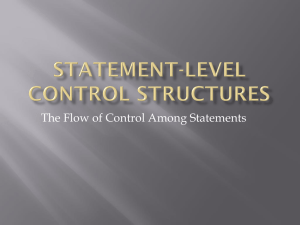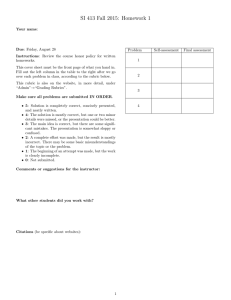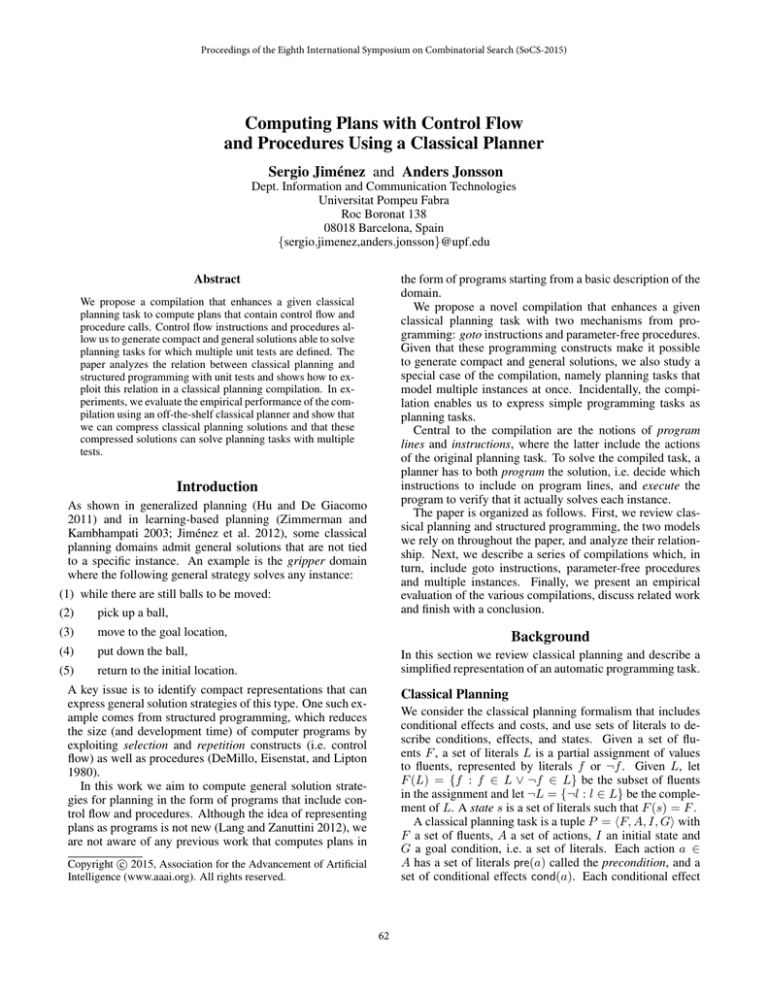
Proceedings of the Eighth International Symposium on Combinatorial Search (SoCS-2015)
Computing Plans with Control Flow
and Procedures Using a Classical Planner
Sergio Jiménez and Anders Jonsson
Dept. Information and Communication Technologies
Universitat Pompeu Fabra
Roc Boronat 138
08018 Barcelona, Spain
{sergio.jimenez,anders.jonsson}@upf.edu
Abstract
the form of programs starting from a basic description of the
domain.
We propose a novel compilation that enhances a given
classical planning task with two mechanisms from programming: goto instructions and parameter-free procedures.
Given that these programming constructs make it possible
to generate compact and general solutions, we also study a
special case of the compilation, namely planning tasks that
model multiple instances at once. Incidentally, the compilation enables us to express simple programming tasks as
planning tasks.
Central to the compilation are the notions of program
lines and instructions, where the latter include the actions
of the original planning task. To solve the compiled task, a
planner has to both program the solution, i.e. decide which
instructions to include on program lines, and execute the
program to verify that it actually solves each instance.
The paper is organized as follows. First, we review classical planning and structured programming, the two models
we rely on throughout the paper, and analyze their relationship. Next, we describe a series of compilations which, in
turn, include goto instructions, parameter-free procedures
and multiple instances. Finally, we present an empirical
evaluation of the various compilations, discuss related work
and finish with a conclusion.
We propose a compilation that enhances a given classical
planning task to compute plans that contain control flow and
procedure calls. Control flow instructions and procedures allow us to generate compact and general solutions able to solve
planning tasks for which multiple unit tests are defined. The
paper analyzes the relation between classical planning and
structured programming with unit tests and shows how to exploit this relation in a classical planning compilation. In experiments, we evaluate the empirical performance of the compilation using an off-the-shelf classical planner and show that
we can compress classical planning solutions and that these
compressed solutions can solve planning tasks with multiple
tests.
Introduction
As shown in generalized planning (Hu and De Giacomo
2011) and in learning-based planning (Zimmerman and
Kambhampati 2003; Jiménez et al. 2012), some classical
planning domains admit general solutions that are not tied
to a specific instance. An example is the gripper domain
where the following general strategy solves any instance:
(1) while there are still balls to be moved:
(2)
pick up a ball,
(3)
move to the goal location,
(4)
put down the ball,
(5)
return to the initial location.
Background
In this section we review classical planning and describe a
simplified representation of an automatic programming task.
A key issue is to identify compact representations that can
express general solution strategies of this type. One such example comes from structured programming, which reduces
the size (and development time) of computer programs by
exploiting selection and repetition constructs (i.e. control
flow) as well as procedures (DeMillo, Eisenstat, and Lipton
1980).
In this work we aim to compute general solution strategies for planning in the form of programs that include control flow and procedures. Although the idea of representing
plans as programs is not new (Lang and Zanuttini 2012), we
are not aware of any previous work that computes plans in
Classical Planning
We consider the classical planning formalism that includes
conditional effects and costs, and use sets of literals to describe conditions, effects, and states. Given a set of fluents F , a set of literals L is a partial assignment of values
to fluents, represented by literals f or ¬f . Given L, let
F (L) = {f : f ∈ L ∨ ¬f ∈ L} be the subset of fluents
in the assignment and let ¬L = {¬l : l ∈ L} be the complement of L. A state s is a set of literals such that F (s) = F .
A classical planning task is a tuple P = hF, A, I, Gi with
F a set of fluents, A a set of actions, I an initial state and
G a goal condition, i.e. a set of literals. Each action a ∈
A has a set of literals pre(a) called the precondition, and a
set of conditional effects cond(a). Each conditional effect
c 2015, Association for the Advancement of Artificial
Copyright Intelligence (www.aaai.org). All rights reserved.
62
C B E ∈ cond(a) is composed of sets of literals C (the
condition) and E (the effect).
Action a is applicable in state s if and only if pre(a) ⊆ s,
and the resulting set of triggered effects is
[
eff(s, a) =
E,
Sequential instruction inc increments the value of a register
and add adds the value of a register to that of another. Control flow instruction goto jumps to program line k 0 if r1 and
r2 have different values, else increments k. Each unit test
t ∈ T sets initial values ti (x)
Pm= m and ti (y) = ti (z) = 0
and desired value td (z) = j=1 j ≤ M for some m. Figure 1 shows an example of a 3-line program for solving this
task.
CBE∈cond(a),C⊆s
i.e. effects whose conditions hold in s. The result of applying a in s is a new state θ(s, a) = (s \ ¬eff(s, a)) ∪ eff(s, a).
A plan solving a planning task P is a sequence of actions
π = ha1 , . . . , an i, inducing a state sequence hs0 , s1 , . . . , sn i
such that s0 = I, G ⊆ sn and the application of each action
ai , 1 ≤ i ≤ n, at state si−1 generates the successor state
si = θ(si−1 , ai ). We define a cost function c : A → N
such thatPthe cost of a plan π is the sum of its action costs,
c(π) = i c(ai ), and π is optimal if c(π) is minimized.
0. inc(y)
1. add(z,y)
2. goto(0,y!=x)
Figure 1: Example program for computing the summatory.
A common extension to automatic programming is procedures, i.e. subsequences of instructions that can be called repeatedly. An automatic programming task with procedures
is a tuple S = hR, Ro , I, T , n, Pi with P the set of procedures, each with n program lines. We consider parameterfree procedures that operate on the same set of registers R.
The set I includes a third type of instruction called procedure call, that does not modify registers but instead executes
a procedure.
A program Π assigns instructions to the program lines of
each procedure in P. In general, to execute a program with
procedures it is necessary to extend the execution model
with a call stack that remembers from where each procedure
was called. In this paper, however, we do not allow nested
procedure calls, in which case execution is easier to manage.
Figure 2 shows an example program for computing the desired value td (z) = 22m − 1 given initial values ti (x) = m
and ti (y) = ti (z) = 0.
Automatic Programming
Our definition of automatic programming is loosely based
on linear genetic programming (Brameier 2004). We define an automatic programming task as a tuple S =
hR, Ro , I, T , ni with R a set of registers, Ro ⊆ R a set of
output registers, I a set of instructions, T a set of unit tests,
each modelling a concrete instance of the problem, and n
a fixed number of program lines. Each register r ∈ R has
finite domain D.
Each instruction i ∈ I has a subset of registers Ri ⊆ R
and is either sequential or control flow. In most programming languages, |Ri | ≤ 3. A sequential instruction i has
a mapping φi : D|Ri | → D|Ri | , and given a joint value
d ∈ D|Ri | , executing i on line k modifies the registers in Ri
as φi (d) and increments k. A control flow instruction i has a
mapping ϕi : D|Ri | → {0, . . . , n, ⊥}, and given d ∈ D|Ri | ,
executing i on line k leaves registers unchanged but sets k
to ϕi (d) if ϕi (d) 6= ⊥, else increments k. Such instructions
can simulate both conditional statements and loops. Each
unit test t ∈ T assigns an initial value ti (r) ∈ D to each
register r ∈ R and a desired value td (r) ∈ D to each output
register r ∈ Ro .
A program Π = hi0 , . . . , im i, m < n, assigns instructions
to program lines. To execute Π on a unit test t ∈ T we
initialize each register r ∈ R to ti (r), initialize a program
counter k to 0 and repeatedly execute the instruction ik on
line k until k > m (we later address the issue of infinite
loops). Π solves S if and only if, for each unit test t ∈ T , the
value of each output register r ∈ Ro is td (r) after executing
Π on t.
As anP
example, consider the task of computing the summ
matory j=1 j of a number m > 0. We can define this
as an automatic programming task S = hR, Ro , I, T , 3i
with R = {x, y, z}, Ro = {z}, D = {0, . . . , M } for some
M > 0 and three types of instructions in I:
Instruction
Ri
φi (d)/ϕi (d)
inc(r1 )
{r1 }
φ(d1 ) = (d1 + 1)
add(r1 , r2 )
{r1 , r2 } φ(d1 , d2 ) = (d1 + d2 , d2 )
ϕ(d1 , d2 ) = k 0 , d1 6= d2
goto(k 0 , r1 != r2 ) {r1 , r2 }
ϕ(d1 , d2 ) = ⊥, d1 = d2
main:
0.
1.
2.
3.
p1
p1
inc(y)
goto(0,y!=x)
p1:
0. add(z,z)
1. inc(z)
Figure 2: Example program for computing z = 22m − 1.
Automatic Programming and Planning
In this section we show that planning and our restricted form
of automatic programming are equivalent in the sense that
one can be reduced to the other. Although our main motivation is to exploit mechanisms from programming (procedures and gotos) to produce compact solutions to classical planning tasks, the equivalence also means that we can
model simple programming tasks as planning problems.
We first define a class P F of planning tasks that we call
precondition-free, i.e. pre(a) = ∅ for each a ∈ A. Although this appears restrictive, note that any action a =
hpre(a), cond(a)i can be compiled into a precondition-free
action a0 = h∅, {(pre(a) ∪ C) B E : C B E ∈ cond(a)}i;
the only difference between a and a0 is that a0 is applicable
when pre(a) does not hold, but has no effect in this case.
Let B PE(P F) be the decision problem of bounded plan existence for precondition-free planning tasks, i.e. deciding if
63
is usually not an issue since |Ri | ≤ 3 for any programming
language based on binary, or possibly tertiary, instructions.
Clearly, P, n is an instance of B PE(P F). Let π =
ha0 , . . . , am i be a plan for P . Since actions simulate instructions, plan π solves P and satisfies |π| ≤ n if and only if
program Π = hi0 , . . . , im i solves S, where ik is the instruction associated with action ak for each k, 0 ≤ k ≤ m.
an arbitrary precondition-free planning task P has a solution
π of length |π| ≤ K. Likewise, let P E(A) be the decision
problem of program existence for the automatic programming tasks.
Theorem 1. B PE(P F) is polynomial-time reducible to
P E(A).
Proof. Given an instance P = hF, A, I, Gi, K of B PE(P F),
construct a programming task S = hF, F (G), I, {t}, Ki.
Since registers are binary, sets of literals are partial assignments to registers. Thus I is the set of initial values of the
only test t, and G is the set of desired values. For each
a ∈ A, I contains an associated sequential instruction i defined as
[
Ri =
F (C) ∪ F (E),
When n is small, we can remove the bound n on the plan
length by encoding a program counter using fluents Fn =
{pck : 0 ≤ k ≤ n}. Given action a, let ak , 0 ≤ k < n, be an
action with precondition pre(ak ) = pre(a) ∪ {pck } and conditional effects cond(ak ) = cond(a)∪{∅B{¬pck , pck+1 }}.
Given an arbitrary planning task P = hF, A, I, Gi, let
Pn = {F ∪ Fn , An , In , G} be a modified planning task with
An = {ak : a ∈ A, 0 ≤ k < n} and In = I ∪ {pc0 } ∪
{¬pck : 1 ≤ k ≤ n}. Since each action in An increments
the program counter and no actions are applicable when pcn
holds, Pn has a solution if and only if P has a solution of
length at most n.
CBE∈cond(a)
φi (d) = (d \ ¬eff(d, a)) ∪ eff(d, a).
Note that fluents not in Ri are irrelevant for computing the
triggered effect of a, so an assignment d to Ri suffices to
compute eff(d, a). Since all instructions in I are sequential,
program Π = hi0 , . . . , im i solves S if and only if m < K
and plan π = ha0 , . . . , am i solves P where, for each k, 0 ≤
k ≤ m, ak is the action associated with instruction ik .
Enhancing Planning Tasks
In this section we show how to enhance planning tasks
with mechanisms from programming: goto instructions,
parameter-free procedures and multiple unit tests. Since we
manipulate planning tasks directly, actions do not have to be
precondition-free.
To show the opposite direction, that programming tasks
can be reduced to planning tasks, we proceed in stages.
We first define a class A LSS of procedure-less programming tasks with sequential instructions and a single test, and
present a reduction from P E(A LSS) to B PE(P F). In the next
section we show how to add control flow instructions, procedures and multiple tests directly to planning tasks.
Goto Instructions
Let P = hF, A, I, Gi be a planning task. The idea is to
define another planning task Pn0 that models a programming
task with n program lines. The set of instructions of the
programming task is A ∪ Igo , i.e. the (sequential) actions
of the planning task P enhanced with goto instructions. We
incorporate the idea of a program counter from the previous
section.
When control flow is not sequential, program lines may be
visited multiple times. To ensure that different instructions
are not executed on the same line, we define a set of fluents
Fins = {insk,i : 0 ≤ k ≤ n, i ∈ A ∪ Igo ∪ {nil, end}}
that each models the instruction i on line k. Instruction nil
denotes an empty line, i.e., a line that has not yet been programmed, while end denotes the end of the program.
Let i ∈ A ∪ Igo ∪ {end} be an actual instruction on line
k, 0 ≤ k ≤ n, and let ik be the compilation of i that updates
the program counter. Since ik may be executed multiple
times, we define two versions: P(ik ), that simultaneously
programs and executes i on line k, and R(ik ), that repeats
the execution of i on line k. Actions P(ik ) and R(ik ) are
defined as
pre(P(ik )) = pre(ik ) ∪ {insk,nil },
Theorem 2. P E(A LSS) is reducible to B PE(P F).
Proof. Let S = hR, Ro , I, {t}, ni be an instance of
P E(A LSS). Construct a planning task P = hF, A, I, Gi
with F = {r[d] : r ∈ R, d ∈ D}. The initial state is
I = {r[ti (r)] : r ∈ R} ∪ {¬r[d] : r ∈ R, d ∈ D − {ti (r)}}
and the goal is G = {r[td (r)] : r ∈ Ro }, where ti (r) and
td (r) are the initial and desired values of register r for the
only test t.
For each instruction i ∈ I, A contains an associated
action a that simulates i. Let us assume that Ri =
{r1 , . . . , rq }. Action a has empty precondition and conditional effects
cond(a) = {{r1 [d1 ], . . . , rq [dq ]}
B {¬r1 [d1 ], r1 [d01 ], . . . , ¬rq [dq ], rq [d0q ]}
: (d1 , . . . , dq ) ∈ Dq , φi (d1 , . . . , dq ) = (d01 , . . . , d0q )}.
Thus a has one conditional effect C B E per joint value
(d1 , . . . , dq ) ∈ Dq that simulates the effect φi (d1 , . . . , dq )
on registers in Ri . To make E well-defined, literals ¬rj [dj ]
and rj [d0j ] are removed from E for each register rj ∈ Ri
such that dj = d0j . Note that the size of cond(a) is exponential in q = |Ri |; however, if we assume that the mapping φi
is explicitly defined in S, the reduction remains polynomial
in the size of S. Moreover, from a practical perspective this
cond(P(ik )) = cond(ik ) ∪ {∅ B {¬insk,nil , insk,i }},
pre(R(ik )) = pre(ik ) ∪ {insk,i },
cond(R(ik )) = cond(ik ).
Hence a programming action (P) is applicable on an empty
line and programs an instruction on that line, while a repeat
action (R) is applicable when an instruction already appears.
64
prog0,inc(v1) [1001]
main: 0.
prog1,add(v0,v1) [1001]
1.
pgoto2,0,v1=5 [1001]
2.
repe0,inc(v1) [1]
repe1,add(v0,v1) [1]
rgoto2,0,v1=5 [1]
repe0,inc(v1) [1]
repe1,add(v0,v1) [1]
rgoto2,0,v1=5 [1]
repe0,inc(v1) [1]
repe1,add(v0,v1) [1]
rgoto2,0,v1=5 [1]
repe0,inc(v1) [1]
repe1,add(v0,v1) [1]
rgoto2,0,v1=5 [1]
end3 [1]
To define goto instructions we designate a subset of fluents C ⊆ F as goto conditions. The set of goto instructions
is Igo = {gotok0 ,f : 0 ≤ k 0 ≤ n, f ∈ C}, modelling control flow instructions goto(k 0 , !f ). The compilation gotokk0 ,f
does not increment the program counter; rather, it is defined
as
pre(gotokk0 ,f ) = {pck },
cond(gotokk0 ,f ) = {∅ B {¬pck }, {¬f } B {pck0 },
{f } B {pck+1 }}.
Without loss of generality we assume k 6= k 0 , else the goto
instruction may cause an infinite loop. In this work we found
it more convenient to model a goto instruction gotokk0 ,f such
that execution jumps to line k 0 if fluent f is false, else execution continues on line k + 1.
We also have to make sure that the execution of the program does not finish on a line with an instruction. For
this reason we define a fluent done which models that we
are done programming. We also define the action endk ,
1 ≤ k ≤ n, as pre(endk ) = {pck } and cond(endk ) =
{∅ B {done}}. Implicitly, programming an end instruction
on line k prevents other actions from being programmed on
the same line, and since endk does not cause execution to
change lines, this causes execution to halt (technically, we
can keep repeating the end action but this does not change
the current state).
We are now ready to define the planning task Pn0 =
hFn0 , A0n , In0 , G0n i. The set of fluents is Fn0 = F ∪ Fn ∪
Fins ∪ {done}. The initial state is defined as
inc(v1)
add(v0,v1)
goto(0,v1!=5)
P5
Figure 3: Example plan generated for computing k=1 k
using two variables v0 and v1, and the corresponding program.
As an example, Figure 3 shows a plan that solves the
P5
problem of computing k=1 k. There are two variables v0
and v1, both initially 0, and the goal is having v0 = 15
and v1 = 5. We include the desired value v1 = 5 to allow the planner to use v1 as an auxiliary variable. The first
three actions in the plan program two sequential instructions
and a goto instruction. The remaining actions represent instructions that are not programmed but repeated and the end
instruction. Figure 3 also shows the resulting program (left
side of the Figure). The solution plan with 16 steps has a
total cost of 3,016 and the program corresponding to this
solution plan has 3 lines of code.
In0 = In ∪ {insk,nil : 0 ≤ k ≤ n} ∪ {¬done}
∪ {¬insk,i : 0 ≤ k ≤ n, i ∈ A ∪ Igo ∪ {end}},
and the goal is G0n = G ∪ {done}. The set of actions is
Procedures
In this section we show how to add procedures to the planning task Pn0 from the previous section. Our current version
does not include a call stack; instead, we only allow procedure calls in the main program and control always returns to
the main program when a procedure finishes. In the future
we plan to model arbitrary procedure calls using a call stack.
Let P = hF, A, I, Gi be a planning task. We compile P into a planning task Pb,n = hFb,n , Ab,n , Ib,n , Gb,n i
with b the number of procedures and n the number of lines
of each procedure. The set of instructions is A ∪ Igo ∪
Ipc ∪ {nil, end}, where Ipc = {callj : 1 ≤ j < b} is
a set of procedure calls. We designate procedure 0 as the
main program. Since Pb,n is similar to the planning task
Pn0 = hFn0 , A0n , In0 , G0n i from the previous section, we only
describe the differences below.
The set Fb,n contains the same fluents as Fn0 with the following modifications:
A0n = {P(ak ), R(ak ) : a ∈ A, 0 ≤ k < n}
∪ {P(gotokk0 ,f ), R(gotokk0 ,f ) : gotok0 ,f ∈ Igo , 0 ≤ k < n}
∪ {P(endk ), R(endk ) : 1 ≤ k ≤ n}.
For each line k, 0 ≤ k ≤ n, the subset of fluents {insk,i :
i ∈ A ∪ Igo ∪ {nil, end}} is an invariant: only insk,nil is
true in the initial state and each action that deletes insk,nil
adds another fluent in the set. Moreover, no action deletes
insk,i for i ∈ A ∪ Igo ∪ {end}. A plan π thus programs
instructions on lines and can never delete an instruction once
programmed.
Let Π be the program induced by fluents of type insk,i at
the end of a plan π for Pn0 . We show that π solves Pn0 if and
only if Π solves P . The actions of π simulate an execution
of Π, updating fluents in F and the program counter and
ending with an action P(endk ), needed to add the goal fluent
done. Action P(endk ) is only applicable on an empty line
and effectively halts execution, so for π to solve Pn0 , the goal
G has to hold when applying P(endk ), i.e. after executing Π.
Since π verifies that Π solves P , Π cannot contain infinite
loops (a planner may spend effort, however, in attempting to
verify an incorrect program).
• Fluents pcj,k and insj,k,i include the procedure j, 0 ≤
j < b, in which a line or instruction appears.
• Fluents insj,k,i include instructions in the set Ipc .
• There is a new fluent main which models that control is
currently with the main program.
65
0
instructions. Since Pb,n
is similar to the planning task Pb,n
from the previous section, we describe the differences below.
0
The set of fluents is Fb,n
= Fb,n ∪ Ftest , where Ftest =
{testt : 1 ≤ t ≤ T } models the active test. Fluent test1 is
initially true while testt is false for 2 ≤ t ≤ T . The initial
state on fluents in F is I 1 , and the goal is G0b,n = GT ∪
{done}. The set A0b,n contains all actions in Ab,n , but we
define action end0,k
differently for each test t, 1 ≤ t ≤ T :
t
Fluent main and program counter pc0,0 are initially true,
all procedure lines are empty, and the goal is Gb,n = G ∪
{done}. The actions from Pn0 are modified as follows:
• Actions aj,k and gotoj,k
k0 ,f include the procedure j, 0 ≤
j < b, and have an extra precondition main for j = 0.
• There is a new action call0,k
that calls procedure j, 1 ≤
j
j < b, on line k, 0 ≤ k < n, of the main program, defined
0,k
as pre(call0,k
j ) = {pc0,k , main} and cond(callj ) = {∅ B
{¬pc0,k , ¬main, pc0,k+1 , pcj,0 }}.
t
pre(end0,k
t ) = G ∪ {pc0,k , main, testt }, t < T,
• Action endj,k is defined differently for j = 0 and j > 0:
cond(end0,k
t ) = {∅ B {¬pc0,k , pc0,0 , ¬testt , testt+1 }}
pre(end0,k ) = {pc0,k , main},
∪ {{¬l} B {l} : l ∈ I t+1 }, t < T,
cond(end0,k ) = {∅ B {done}},
pre(end
j,k
) = {pcj,k }, j > 0,
j,k
) = {∅ B {¬pcj,k , main}}, j > 0.
cond(end
pre(end0,k
T ) = {pc0,k , main, testT },
cond(end0,k
T ) = {∅ B {done}}.
For t < T , action end0,k
is applicable when Gt and testt
t
hold, and the effect is resetting the program counter to pc0,0 ,
incrementing the current test and setting fluents in F to their
value in the initial state I t+1 of the next test. Action end0,k
T
is defined as before, and is needed to achieve the goal fluent
0,k
done. As before, we add actions P(end0,k
t ) and R(endt )
0
to the set Ab,n for each t, 1 ≤ t ≤ T , and k, 1 ≤ k ≤ n.
0
To solve Pb,n
, a plan π has to simulate an execution of the
induced program Π on each of the T tests; hence π solves
0
if and only if Π solves P t for each t, 1 ≤ t ≤ T .
Pb,n
The effect of endj,k , j > 0, is to end procedure j on line k
and return control to the main. The set Ab,n is defined as
Ab,n = {P(aj,k ), R(aj,k ) : a ∈ A, 0 ≤ j < b, 0 ≤ k < n}
∪ {P(gotoj,k
k0 ,f ) : gotok0 ,f ∈ Igo , 0 ≤ j < b, 0 ≤ k < n}
∪ {R(gotoj,k
k0 ,f ) : gotok0 ,f ∈ Igo , 0 ≤ j < b, 0 ≤ k < n}
0,k
∪ {P(call0,k
j ), R(callj ) : callj ∈ Ipc , 0 ≤ k < n}
∪ {P(endj,k ), R(endj,k ) : 0 ≤ j < b, 1 ≤ k ≤ n}.
Similarly to the previous section, we show that a plan π
solves Pb,n if and only if the induced program Π solves P .
At the end of π, the fluents insj,k,i describe a program, i.e. an
assignment of instructions to the program lines of each procedure. To solve Pb,n , π has to simulate an execution of Π,
including calls to procedures from the main program. Note
that both calling procedures and ending procedures may be
j,k
repeated due to actions R(call0,k
), in case a
j ) and R(end
procedure is called multiple times on the same line of the
main program. Plan π ends with a call to P(end0,k ) for some
k, 1 ≤ k ≤ n.
Evaluation
The evaluation is carried out in the following domains: The
summatory domain models the computation of the summatory of m as described in the working example. Tests for
this domain assign values to m in the range [2, 11] and are
solved by the 3-line program of Figure 1.
The find, count and reverse domains model programming tasks for list manipulation; respectively, finding the
first occurrence of an element x in a list, counting the occurrences of an element x in a list and reversing the elements of a list. The tests for find include lists with sizes
in the range [15, 24], the element could be found in the list
in all the tests so they can be solved using the 2-line program (0. inc(i), 1. goto(0, list[i]!=x)). The tests for the
count domain have list lengths [5, 14] and can be solved by
the 4-line program (0. goto(2, list[i]!=x), 1. inc(counter),
2. dec(i), 3. goto(0, i!=0)). Tests for the reverse domain
also range the list length in [5, 14] and can be solved by
program (0. swap(head, tail), 1. inc(head), 2. dec(tail),
3. goto(0, head!=tail&head!=tail+1)).
We believe that the above programming tasks are good
benchmarks to illustrate the performance of our compilation
when addressing planning tasks with multiple tests. However, we acknowledge that modelling programming tasks as
classical planning tasks may not be the most efficient approach. In the future we plan to explore our compilation
approach using other planning languages that more naturally handle numerical representations such as functional
Multiple Tests
When we include multiple tests, we essentially ask the planner to come up with a single program that solves a series of
instances, each of which has a different initial state and goal
condition. In many cases, this is impossible without control
flow instructions. Consider the example in Figure 1. We
cannot generate a single sequence of inc and add actions
that computes the summatory for different values of m (if,
however, we add instructions for multiplication and division,
we can compute the summatory as m(m + 1)/2).
To model multiple tests we assume that the input is a
series of planning tasks P 1 = hF, A, I 1 , G1 i, . . . , P T =
hF, A, I T , GT i that share fluents and actions but have different initial states and goal conditions. We define a planning
0
0
0
task Pb,n
= hFb,n
, A0b,n , Ib,n
, G0b,n i that models a program1
ming task for solving P , . . . , P T using procedures and goto
66
baseline
1-3
1-5
1-7
1-10
2-3
2-5
2-7
2-10
count[10]
2.94
5.00
9.00
8.24
8.24
8.2
9.00
8.24
6.57
diagonal[10]
1.19
10.00
10.00
3.00
1.00
10.00
1.00
1.75
1.00
find[10]
2.32
10.00
10.00
10.00
10.00
10.00
10.00
10.00
10.00
grid[10]
4.85
5.00
10.00
10.00
10.00
9.00
10.00
10.00
8.8
gripper[10]
1.77
0
10.00
10.00
6.3
8.31
9.56
4.92
6.3
lightbot[4]
2.47
1.00
1.00
1.00
2.67
1.00
1.6
2.00
1.67
maze[20]
13.59
11.00
14.00
15.66
16.54
15.29
15.29
16.63
15.51
reverse[10]
6.03
0
8.00
5.26
3.8
5.66
6.8
4.85
3.00
summatory[10]
3.94
10.00
8.4
4.18
4.81
8.68
4.71
4.3
3.59
unstack[10]
1.19
10.00
10.00
9.25
6.86
10.00
10.00
8.11
4.37
Table 1: Quality IPC scores obtained by our compilation with parameters b-n bounding the number of procedures b = {1, 2} and their sizes
n = {3, 5, 7, 10}. Fast Downward run on the original planning tasks serves as a baseline (with a number of program instructions equal to the
plan length). The number of problems per domain is in square brackets.
S TRIPS (Francés and Geffner 2015) and that are therefore
better at modelling programming tasks.
The remaining domains are adaptations of existing planning domains. The diagonal and grid domains model
navigation tasks in an n × n grid. In both cases, an
agent starts at the bottom left corner, and has to reach the
top right corner (diagonal) or an arbitrary location (grid).
Tests for diagonal include grids with sizes in the range
[10, 19] and can be solved by the 3-line program (0. right,
1. up, 2. goto(0, x!= xgoal )). In grid the grid size is in
the range [5, 14] and can be solved with the 6-line program (0. goto(2, true), 1. right, 2. goto(1, x!= xgoal ),
3. goto(5, true) 4. up, 5. goto(4, y!= ygoal )).
Finally, the gripper domain models the transport of
n balls from a source to a destination room and the
unstack domain models the task of unstacking a tower
of n blocks. In gripper, the number of balls is in
the range [6, 15] and instances are solved by the program (0. pickup, 1. move, 2. goto(0, atRobot!=roomB),
3. drop, 4. goto(1, ballsroomA !=0)). In unstack the program (0. putdown, 1. unstack, 2. goto(0, ¬handempty))
solves the tests which have a number of blocks in the range
[10, 19].
Despite the fact that the number of lines required to generate these programs is small, this does not mean that the
explored search space is trivial, especially in the case of multiple tests. In this setting the task of simultaneously generating and validating programs for a set of tests often require
plans that include tens of actions.
In all experiments, we run the forward-search classical
planner Fast Downward (Helmert 2006) using the SEQ - SATLAMA -2011 setting (Richter and Westphal 2010) with time
bound of 1,800 seconds and memory bound of 4GB RAM.
To generate compact programs in this setting we define a
cost structure that assigns high cost to programming an instruction and low cost to repeating the execution of a programmed instruction. More precisely, we let c(P(i)) =
1, 001 and c(R(i)) = 1 for each instruction i.
scribed above. In addition, two extra domains are added,
maze and lightbot that model programming tasks from the
Hour of Code initiative (csedweek.org and code.org).
The size of a solution to a classical planning task is assessed here by the number of instructions in the program
obtained from that solution. To serve as a baseline we ran
Fast Downward on the original planning task, i.e., no gotos
or procedures are allowed. Table 1 summarizes the results
achieved by the baseline and our compilation with parameters b ∈ {1, 2} and n ∈ {3, 5, 7, 10} bounding the number
of procedures and their sizes. The table reports the IPC quality score (Linares López, Jiménez, and Helmert 2013) with
the quality of a plan given by the number of instructions of
the program extracted from it. In the case of the baseline
the number of program instructions always equals the plan
length.
The difference in the scores of the baseline and the various
configurations of our compilation becomes larger for larger
problems. An illustrative example is the diagonal domain
where any configuration of the compilation compresses solution plans to the 3-instruction program (0. right, 1. up,
2. goto(0, x!= n)) while the baseline plans keep growing
with the grid size.
Solving Planning Tasks with Multiple Tests
The second experiment evaluates the performance of our approach on programming tasks with multiple tests. Each domain comprises now 10 problems such that the ith problem includes the first i tests defined above, 1 ≤ i ≤ 10.
In this respect different tests encode different initial states
and different goals. Solving this kind of planning tasks is
impossible without handling control flow instructions therefore the baseline results are not included. Maze and lightbot
are skipped here because no general solution solves different
problems in these domains.
Table 2 reports the number of problems solved in each do0
main after compiling them into a planning task Pb,n
, where
b ∈ {1, 2} and n ∈ {3, 5, 7, 10}. Each cell in the table
shows two numbers: problems solved when goto conditions
can be any fluent/only fluents in C ⊆ F . The C subset comprises the dynamic fluents of the original planning tasks, i.e.
fluents that can be either added or deleted by an original action, and fluents equal(x, y) added to the compiled task in
the form of derived predicates (Thiébaux, Hoffmann, and
Compacting Solutions to Classical Planning
The first experiment evaluates the capacity of our compilation to compact solutions to classical planning tasks. Benchmark problems in this experiment are single-test tasks where
each problem represents one of the ten tests per domain de-
67
1-3
1-5
1-7
1-10
2-3
2-5
2-7
2-10
count[10]
0/0
1/5
3/3
3/3
3/3
3/1
3/3
3/3
diagonal[10]
10/10
9/10
1/9
1/1
10/10
4/4
1/2
1/1
find[10]
10/10
8/10
1/10
1/10
10/10
6/10
1/10
1/10
grid[10]
1/1
5/10
4/4
2/1
10/10
2/5
2/2
2/1
gripper[10]
0/0
10/10
9/10
4/10
1/10
10/10
4/10
2/10
reverse[10]
0/0
3/4
2/2
1/1
4/4
4/3
1/2
1/1
summatory[10]
4/8
3/8
2/7
1/6
2/8
3/8
2/6
1/4
unstack[10]
7/7
3/3
2/2
2/2
8/8
2/2
2/2
0/0
Table 2: Problems solved by our compilation with parameters b = {1, 2} and n = {3, 5, 7, 10} when goto conditions can be: any fluent/only
fluents in C ⊆ F . Each domain comprises 10 problems such that the ith problem includes the first i tests defined above.
• Generalized planning also aims at synthesizing general
strategies that solve a set of planning problems (Levesque
2005; Hu and De Giacomo 2011). A common approach
is planning for the problems in the set and incrementally merging the solutions (Winner and Veloso 2003;
Srivastava et al. 2011). A key issue here is handling a
compact representation of the solutions that can effectively achieve the generalization. Our work exploits gotos and procedure calls to represent such general strategies; in addition, programs are built in a single classical planning episode by assigning different costs for programming and executing instructions and exploiting the
cost-bound search of state-of-the-art planners.
Nebel 2005) to capture when two variables have the same
value. Limiting conditions reduces the possible number of
goto instructions and therefore the state space and branching
factor of the planning task.
No unique parameter setup consistently works best because the optimal number of procedures and program lines
depend on the particular program structure. A small number of lines is insufficient to find some programs, while a
large number of lines increases the search space and consequently, the planning effort. Examples of the former are the
gripper and reverse domains where configuration 1-3 cannot
solve a single problem. Examples of the latter are the diagonal and find domains where configurations *-10 only solve
one problem. Likewise procedures are useful in particular
domains. In the grid domain the 2-3 configuration solves all
problems while 1-3 only solves 1. The generated program
is (0. up, 1. goto(0, y!= ygoal ), 2. p1) where procedure p1 is
defined as (0. right, 1. goto(0, x!= xgoal )) . The same happens in the gripper domain where program (0. pickup, 1. p1,
2. goto(0, ballsroomA ! = 0)) with p1 defined as (0. move,
1. drop, 2. move) also solves all problems.
• Also related is work on deriving Finite-State Machines
(FSMs) (Bonet, Palacios, and Geffner 2010), which uses
a compilation that interleaves building a FSM with verifying that the FSM solves different problems. Procedureless programs can be viewed as a special case of FSMs in
which branching only occurs as a result of goto instructions. However, a single FSM cannot represent multiple
calls to a procedure without a significant increase in the
number of machine states. The generation of the FSMs
is also different since it starts from a partially observable
planning model and uses a conformant into classical planning compilation (Palacios and Geffner 2009).
Related Work
The contributions of this paper are related to work in different research areas of artificial intelligence.
• Automatic program generation. Like in programming by
example (Gulwani 2012) our approach attempts to generate programs starting from input-output examples. In contrast to earlier work, our approach is compilation-based
and exploits the model of the instructions with off-theshelf planning languages and algorithms.
• Compiling Domain-Specific Knowledge (DSK) into
PDDL. Our programs and procedures can be viewed
as DSK control knowledge. There is previous work
on successful compilations of DSK into PDDL such as
compiling HTNs into PDDL (Alford, Kuter, and Nau
2009), compiling LTL formulas (Cresswell and Coddington 2004) or compiling procedural domain control (Baier,
Fritz, and McIlraith 2007). However, unlike previous
work our approach automatically generates the DSK online.
• Our work is also related to knowledge-based programs
for planning (Lang and Zanuttini 2012) which, just like
our compilation, incorporate selection and repetition constructs into plans. No procedures are allowed, however,
and existing work is purely theoretical, analyzing the
computational complexity of decision problems related to
knowledge-based programs in planning.
• There is a large body of work on learning for planning (Zimmerman and Kambhampati 2003; Jiménez et al.
2012), with macro-action learning being one of the most
successful approaches (Botea et al. 2005; Coles and Smith
2007). In the absence of control flow our procedures can
be understood as parameter-free macro-actions. A natural
future direction is then to study how to reuse our programs
and procedures in similar planning tasks.
Conclusion
In this paper we introduce a novel compilation for incorporating control flow and procedures into classical planning.
We also extend the compilation to include multiple unit tests,
68
Cresswell, S., and Coddington, A. M. 2004. Compilation
of ltl goal formulas into pddl. In European Conference on
Artificial Intelligence.
DeMillo, R. A.; Eisenstat, S. C.; and Lipton, R. J. 1980.
Space-Time Trade-Offs in Structured Programming: An
Improved Combinatorial Embedding Theorem. J. ACM
27(1):123–127.
Francés, G., and Geffner, H. 2015. Modeling and computation in planning: Better heuristics from more expressive
languages. In International Conference on Automated Planning and Scheduling.
Gulwani, S. 2012. Synthesis from examples: Interaction
models and algorithms. In International Symposium on Symbolic and Numeric Algorithms for Scientific Computing.
Helmert, M. 2006. The Fast Downward Planning System.
Journal of Artificial Intelligence Research 26:191–246.
Hu, Y., and De Giacomo, G. 2011. Generalized planning: Synthesizing plans that work for multiple environments. In International Joint Conference on Artificial Intelligence, 918–923.
Jiménez, S.; De La Rosa, T.; Fernández, S.; Fernández, F.;
and Borrajo, D. 2012. A review of machine learning for
automated planning. The Knowledge Engineering Review
27(04):433–467.
Lang, J., and Zanuttini, B. 2012. European conference on
artificial intelligence. In ECAI.
Levesque, H. J. 2005. Planning with loops. In International
Joint Conference on Artificial Intelligence, 509–515.
Linares López, C.; Jiménez, S.; and Helmert, M. 2013. Automating the evaluation of planning systems. AI Communications 26(4):331–354.
Palacios, H., and Geffner, H. 2009. Compiling uncertainty
away in conformant planning problems with bounded width.
Journal of Artificial Intelligence Research 35:623–675.
Richter, S., and Westphal, M. 2010. The LAMA Planner:
Guiding Cost-Based Anytime Planning with Landmarks.
Journal of Artificial Intelligence Research 39:127–177.
Rintanen, J. 2012. Planning as satisfiability: Heuristics.
Artificial Intelligence Journal 193:45–86.
Srivastava, S.; Immerman, N.; Zilberstein, S.; and Zhang,
T. 2011. Directed search for generalized plans using classical planners. In International Conference on Automated
Planning and Scheduling.
Thiébaux, S.; Hoffmann, J.; and Nebel, B. 2005. In defense of {PDDL} axioms. Artificial Intelligence Journal
168(12):38 – 69.
Winner, E., and Veloso, M. 2003. Distill: Towards learning domain-specific planners by example. In International
Conference on Machine Learning.
Zimmerman, T., and Kambhampati, S. 2003. Learningassisted automated planning: Looking back, taking stock,
going forward. AI Magazine 24(2):73.
i.e. multiple instances of related, similar problems. The result of the compilation is a single classical planning task
that can be solved using an off-the-shelf classical planner to
generate compact solutions to the original task in the form
of programs. In experiments we show that the compilation
often enables us to generate solutions that are much more
compact than a simple sequence of actions, as well as generalized solutions that can solve a series of related planning
tasks.
As is common in works in automatic programming, the
optimal parameter settings depend on the task to be solved.
A sufficient program size is key for the performance of the
approach and too many procedures with too many lines result in tasks too large to be solved by an off-the-shelf planner. Two ways to address this issue would be to implement
the successor rules of our compilation explicitly into a planner or iteratively increment the compilation bounds, like in
SAT-based planning (Rintanen 2012).
The scalability of our compilation is also an issue. On the
positive side, a small number of tests is often sufficient to
achieve a generalized solution. For instance, no configuration solved all the summatory problems but solving a problem that only includes two tests already produces a general
program. In the future we plan to explore our compilation
approach using a planning language that more naturally handle numerical representations. In particular we plan to use
functional S TRIPS (Francés and Geffner 2015) to improve
the scalability of our approach.
Acknowledgment
Sergio Jiménez is partially supported by the Juan de la Cierva program funded by the Spanish government.
References
Alford, R.; Kuter, U.; and Nau, D. S. 2009. Translating
HTNs to PDDL: A Small Amount of Domain Knowledge
Can Go a Long Way. In International Joint Conference on
Artificial Intelligence.
Baier, J. A.; Fritz, C.; and McIlraith, S. A. 2007. Exploiting procedural domain control knowledge in state-of-the-art
planners. In International Conference on Automated Planning and Scheduling.
Bonet, B.; Palacios, H.; and Geffner, H. 2010. Automatic
Derivation of Finite-State Machines for Behavior Control.
In AAAI.
Botea, A.; Enzenberger, M.; Mller, M.; and Schaeffer, J.
2005. Macro-ff: Improving ai planning with automatically
learned macro-operators. Journal of Artificial Intelligence
Research 24:581–621.
Brameier, M. 2004. On Linear Genetic Programming.
Ph.D. Dissertation, Fachbereich Informatik, Universit”at
Dortmund, Germany.
Coles, A., and Smith, A. 2007. Marvin: A heuristic search
planner with online macro-action learning. Journal of Artificial Intelligence Research 28:119–156.
69

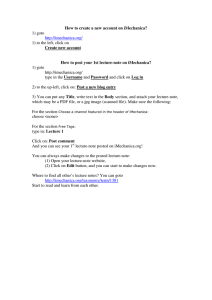
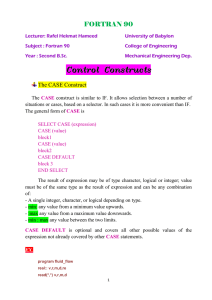
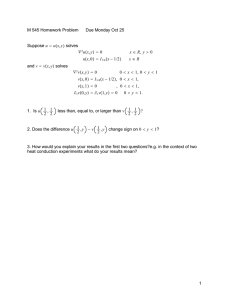
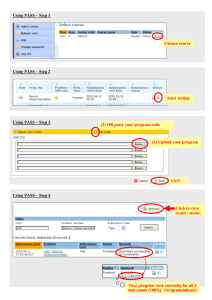
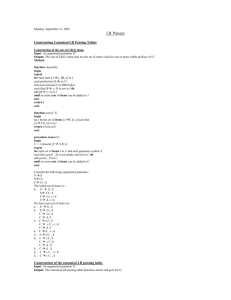
![11th grade 2nd quarter study guide[1]](http://s2.studylib.net/store/data/010189415_1-a4e600e9fc2ee42639f67b298d930b48-300x300.png)
